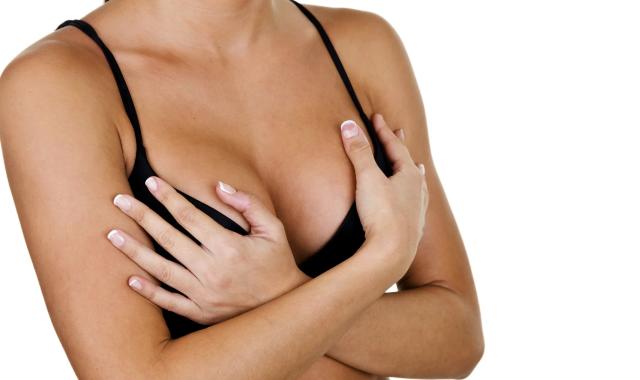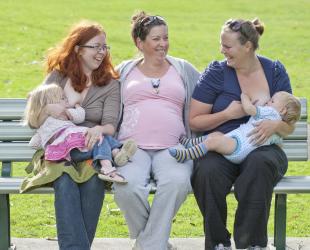Talking about sore or damaged nipples
Is breastfeeding supposed to be painful? How can I prevent or recover from cracked and damaged nipples? In this episode, Nicole and Simone talk about the early days of breastfeeding, sore nipples and some simple management strategies. They will also discuss what to do if these strategies aren’t enough.

Podcast episode
Companion blog post
Nipple skin is super sensitive and any sort of grazes or cracks on it can cause toe-curling pain. When breastfeeding mums discover their nipples are damaged, just thinking about putting them in their baby’s mouth to suck can send them into floods of tears. I’m hoping to water down some of these floods by explaining how cracks actually happen and what you can do next to help them heal.
Podcast information
Talking about sore or damaged nipples
Is breastfeeding supposed to be painful? How can I prevent or recover from cracked and damaged nipples? In this episode, Nicole and Simone talk about the early days of breastfeeding, sore nipples and some simple management strategies. They will also discuss what to do if these strategies aren’t enough.
Information discussed in this episode:
- Attachment to the breast
- Sore and cracked nipples
- Nipple infections
- Purchase our booklet, Breastfeeding: breast and nipple care
Credits:
This episode is presented by Nicole Bridges and Simone Casey. Special thanks to Jamie Errico.
Show notes by Emma Pennell. Transcription by Madina Hajher. Produced by Belinda Chambers, Sky Mykyta, Jessica Leonard and Eleanor Kippen.
SIMONE: When we think about what nipples and this baby going to be sucking on them all the time, I think it gets a little bit scary for some parents, so the thought that they can get a cracked nipple or can have a scab on their nipple is a pretty awful thought. And when it does actually happen it really can play with the mums’ heads a little bit and they get quite upset thinking it might be like this forever or this is how breastfeeding feels forever … and it is often a very temporary issue, but very, very important to get onto quickly.
SKY: Welcome to Breastfeeding … with ABA. A new podcast brought to you by volunteers from the Australian Breastfeeding Association. Breastfeeding … with ABA is a podcast about breastfeeding, made by parents, for parents. We are recording this podcast in different parts of Australia. We acknowledge the Traditional Custodians of the land on which we are recording and on which you are listening to this podcast. We pay our respects to elders past, present and emerging and to any Aboriginal people who are listening today. We also acknowledge Aboriginal women who have breastfed their babies and raised their families up on this country for thousands of years.
NICOLE: So, today we’re going to be talking a little bit about cracked and damaged nipples. It’s one of the most common helpline calls that we get, and many new mums are really keen to get it sorted out straight away because it can be quite painful to have cracked and damaged nipples. My name is Nicole Bridges, I’m a breastfeeding counsellor with the Australian Breastfeeding Association, and community educator. And I’m here today with Simone Casey. Hi Simone.
SIMONE: Hi Nicole, I’m Simone. I’m a breastfeeding counsellor with the Australian Breastfeeding Association, like you, and also an International Board Certified Lactation Consultant.
NICOLE: So, thanks for being here today, Simone. It will be really fantastic to draw on your professional knowledge as well as your knowledge as an ABA volunteer. So, essentially cracked and damaged nipples usually become that way most of the time because the baby isn’t actually correctly attached to the breast. Probably heard of lots of other reasons, have you heard of other reasons perhaps, Simone, why some people think that there might be damage to the nipple?
SIMONE: Oh yeah, I hear all of them. A lot of people tell me that their nipples are damaged or cracked because the baby is feeding so often, which can be more worrisome for the mum if they are feeding a lot and also, it’s painful that sort of makes them go, ‘Oh I don’t want to feed anymore because it’s hurting so much.’ Overuse of the nipples isn’t really a reason, it’s if the attachment is incorrect. So …
NICOLE: Because my babies were feeding so frequently, then if that were the case I would be really, really in trouble!
SIMONE: Yeah, that’s right. So, it’s not overuse, and also you hear all these funny stories that if you’ve got red hair or fair skin you might have very sensitive skin and then they’re very sore, which isn’t usually the case either. So, there’s lots of myths about why you might get a cracked or sore nipple and almost always it will go back to that whole thing you were talking about with positioning and attachment. How the nipples actually crack in the first place. So, when the nipple isn’t far enough back in the baby’s mouth, so we’re talking about the hard palate and the soft palate. And the hard palate is the roof of the mouth, and the soft palate is beyond that, and the nipple has to stretch to get into that part and then, if it doesn’t, it rubs against that hard palate and it is friction that causes the crack. So, it is almost always deeper attachment that we need to do to get that nipple far back.
NICOLE: Yeah, and it literally can be only 1 millimetre deeper which is what makes the difference, so it can be really the most subtle and minute change that makes the world of difference for a mum.
SIMONE: Yeah, and often I’ll watch a mum attach and it actually visibly looks okay but it’s still hurting her, so I’ll see where the baby’s mouth is and where the areola is and then we’ll work and get a bit of a deeper one and I’ll say to her, ‘I reckon that’s only 2 mm different’ and she’ll go, ‘Yeah feels way better.’
NICOLE: So, speaking of which, how does a mum know if her baby is attached correctly? What does it feel like for her, what does it look like from her perspective?
SIMONE: Yeah, so I’m going to say if the baby is well attached you can feel a sort of a pull or a vacuum feeling with the baby, if the nipple is in the baby’s mouth, but it shouldn’t pinch or feel painful or sore while they’re doing that or stabbing pains or anything like that. It really should be just a bit of a pull and that’s it, and hopefully fairly comfortable.
NICOLE: Okay. Lots of mothers come to us or call us on helpline and saying that they’ve got recurring issues with painful attachment, that they spoke to a healthcare professional and they said it looked okay so it must be okay, but that’s actually not always the case. And I think we should really emphasise that mums should trust their own instincts, and if it doesn’t feel okay, ask someone else for help. Keep asking for help until you find someone who will believe you and will give you the help that you need. Because it shouldn’t be like that and we shouldn’t have to put up with that ongoing pain.
SIMONE: Right, that’s right. I also say to mums don’t expect perfection straight away. You’re both learning together, you and your baby, and then if we can’t get a 100 percent correctly instantly, you know, it’s like a person in a new job. You’re not going to get it right in the first week or the second week, or maybe in a month you’ve still a couple of mistakes. So, sometimes it is a work in progress a little bit. We don’t want toe-curling pain every single time you attach, but sometimes I ask mums to be a bit of a pain scale and so if it’s really that horrible pain, you might say it’s 9 or 10 out of 10, but if we wait 10 seconds into the feed and the nipple is stretched into the back of the mouth and actually it drops back and they say, ‘Oh that’s a 6 out of 10, and actually now it’s a 4’ and if we can improve and improve with the attachment we might get it down to a 2, but if they try to get better than a 2 they might find that they’re reattaching, reattaching, reattaching and that’s not going to be great at that time. So, maybe accepting a 2 out of 10 for a couple of days until you can improve a little bit more. So, that’s why I sort of jump to use that pain scale sometimes and that really helps so that they’re not going to attach even if they feel just the slightest bit of pain whereas at least if it’s a lot better than what it was before, we’re chipping away and getting better.
NICOLE: Absolutely, they’re all good points.
JAMIE: You are listening to Breastfeeding … with ABA. My name is Jamie, and I am a volunteer breastfeeding counsellor with the Australian Breastfeeding Association. I became involved with the ABA when I was pregnant with my first baby and attended a Breastfeeding Education Class. I took away a foundational Breastfeeding 101 and knew I would always have somewhere to turn for help. I attended my first group meeting before my daughter’s arrival and knew I had found a group of mothers who would help me through the ups and downs of both breastfeeding and motherhood. The ongoing support I have received as a mother of three children and a volunteer is second to none. The friends I have met through the ABA continue to encourage and motivate me to give back to mothers.
JESSICA: To find out more about ABA’s face to face Breastfeeding Education Classes, or Breastfeeding Education Live interactive webinars, visit breastfeeding.asn.au/classes
NICOLE: What are your thoughts on nipple creams, Simone? I know that sometimes they can provide short term relief, but my understanding is what can end up happening is the nipple is kept too moist for too long and that can actually help promote infection which of course we want to avoid.
SIMONE: Yeah, that’s right. And I have seen mums that have got thrush and other types of bacterial infections from having very soggy nipples, as I call them, from overuse of creams and sometimes you can buy all sorts of little aloe vera gel pads, lots of little sort of moistening things you can put on the nipples that don’t necessarily help long term.
NICOLE: Yeah, that’s good to know.
SIMONE: The other thing that people can usually tell is if babies detach from the breast and they look at the nipple, there can be quite a like a light compression stripe along the end of the nipple and that’s a sign that the baby hasn’t been on well, as well. So those are sort of things to look out for, but just working on getting that positioning and attachment right is usually the main, main thing. But most of the time when the mums can’t get the attachment right, almost always when I watch them, they haven’t got the baby close enough to the breast, so they really need to have that chest to chest position. A lot of mums will just hold the baby in line with their chest, and I’ll just point out, ‘I shouldn’t be able to get my hand between that baby and your chest. The baby needs to be very much pressed to your chest so that that gives them the best opportunity to get close enough to the breast to have a good latch.’ Sometimes their hands are in the way, and they’ve sort of got their hands folded across their chests, and mums do find that hands get in the way a lot, and that’s probably because they’re taking such a long time to try and attach, the baby’s desperate to crawl to the breast so those sorts of things can happen too. So, getting that baby really, really close to the chest can help them to calm down to know that they’re there, but also to get close enough so that their mouth and chin and everything are all going to line up and get into the right spot.
NICOLE: Yeah, because I know it’s really important to get that chin nice and deep into the breast, as well, so that the baby’s tipping their head back in that ideal position so that they can drink the milk, too.
SIMONE: I often talk a lot about chins when I’m helping mums to attach because I think they focus on the nipple and the baby’s lips, and a lot of time what we need to do is press the baby very close making sure the chin is the first point of contact with the breast which in turn makes the baby’s head tip back as you said, and then when the head’s tipped back you can give a little bit of a push between the shoulder blades or a bit of a roll towards you so that then the baby’s mouth goes up and over the nipple.
NICOLE: Yeah, all good points. So, how can a mum tell when things are actually improving and what she’s doing is working?
SIMONE: I think for one thing, the pain should be starting to improve. So, if your baby is attached well, then you’re going to feel that pull sensation and not the nipple cracking and the nipple soreness.
NICOLE: So, I’d just like to thank you again Simone for having a chat to me today. I think this kind of information, it’s really basic but extremely important information for new mums. Because as we said in the beginning, it’s one of the most common helpline calls, it’s one of the, I think it’s also antenatally one of the things that parents are most afraid of.
SIMONE: Yeah, I think when we think about your nipples and this baby going to be sucking on them all the time, I think it gets a little bit scary for some parents, the thought that they can get a cracked nipple or can have a scab on their nipple is a pretty awful thought. And when it does actually happen it really can play with the mums’ heads a little bit and they get quite upset thinking it might be like this forever or this is how breastfeeding feels forever, and it is often a very temporary issue, but very, very important to get onto quickly. And usually needing some one-on-one help with that and that might be a feeding clinic in your area or something like that as well.
JESSICA: Most of the time, cracked and sore nipples are caused by issues with positioning and attachment. You can speak to an ABA breastfeeding counsellor, your child health nurse, a midwife or a lactation consultant to help improve positioning and attachment. But every now and then the issue is something else like an infection, or dermatitis on your nipples, maybe a tongue-tie in your baby, or issues with using a breast pump in the wrong way. So, if you think there might be something medical going on, or you need help with pain relief, or things are healing really slowly, make sure you speak to your health professional. But here are a few things that you can try while your nipples are healing. Before you feed your baby, keep in mind that you can offer a feed before your baby starts crying, so look out for earlier signs that your baby might be ready for a feed. Things like turning the head and rooting around and trying to find the breast or sucking on their hands. Get into a nice, comfortable position and relax as much as you can. Some people find it helpful to take some slow, relaxing breaths. Gently massaging your breasts and using a warm compress can help get your milk flowing. And you can also hand express some milk to soften the areola. Some things that you can try during feeds are things like offering the less sore side first and trying different feeding positions. Focus on improving position and attachment, if you need help with this you can call our breastfeeding helpline, so that’s 1800 MUM2MUM, 1800 686 268. If positioning and attachment isn’t feeling quite right and it’s a bit painful, one option is to take your baby off the breast and start again. So gently break the suction by putting a clean finger into the corner of your baby’s mouth then take them off the breast. But you can also try changing the position before you take them off to see if it helps. So, pull your baby in nice and close to your body, and try leaning back a little bit to see if it feels any better. Some mums do choose to take a break from feeding from the sore breast for 12 to 24 hours to rest the nipple and let the healing start. So, if you want to give this a try, you can express breastmilk to feed your baby. This will also help to keep you comfortable and to maintain your supply. A lot of people find that in this situation hand expressing is easier than using a pump because it means you can avoid more damage to your nipples. You can find information on feeding expressed breastmilk to your baby on our website. So that also includes information on how to feed your baby from a cup. And some people also decide to limit the amount of comfort feeding their baby does while their nipples are recovering. After feeds, have a look and check out your nipples and see if there’s any sign of stress there. So, things like red stripes or a little white line across the end of your nipple, or a squashed look. So, I sometimes say that a squashed nipple can look a bit like a fresh lipstick. So, if that’s happening to you, it could be a sign that you need some help with positioning and attachment. After a feed you can also express a few drops of milk and smear that on your nipples. But make sure you speak to your health professional before you use any other creams or ointments on your nipples just to make sure that it’s the right choice for you. You can also gently wash your nipples once a day with a mild soap and warm water, so like in the shower, and this can help to prevent any infections from forming. So, there’s just a few things you can try if you’re having issues with sore and cracked nipples.
NICOLE: So, I think it’s really important as well for mums to understand where they can go for additional help and resources, so I’ll just quickly run through a few of those now. Of course, first and foremost the Australian Breastfeeding Association’s Breastfeeding Helpline is operating free of charge, 24/7, and that’s 1800 686 268. Sometimes it’s really good as a first port of call to just actually touch base with a breastfeeding counsellor and talk things through because often if you are having repeated issues with cracked and damaged nipples, there might be some hints and tips that that counsellor can provide to you to just help you get things on the way. We also have lots of amazing resources on our website. It’s always a great idea, to start with, to perhaps pop in the search bar ‘cracked nipples’ and that will find you lots of results. But there are three information sheets in particular I’m thinking of. There’s one called ‘Attachment to the Breast’, another called ‘Sore and Cracked Nipples’, and a third one called ‘Nipple Infections’. So, these would be quite pertinent for today’s topic, and of course we also we sell a booklet through our e-store called ‘Breast and Nipple Care’ which is of course designed specifically for this topic, too. We also have LiveChat. I’m not quite sure if everyone’s aware of that. It’s a fairly new service we started in the last year or so. At the moment it’s currently operating on weeknights from 8 to 10 pm AEST and it’s a great place you can just type in your quick query onto our website and a community educator can also point you in the right direction for resources. So, if you are having a little bit of trouble finding those resources on our website, perhaps popping on between those hours on a weeknight you can be connected with a community educator who can help you and also identify if you might need to speak to a counsellor as well. So, if they identify that your problem perhaps needs a little bit more one-on-one help, they’ll also refer you onto the helpline. So that’s also a really great service. Finally, I guess if mums are feeling that they’ve resolved their attachment, but they still have ongoing breast and nipple pain that isn’t resolved, then it’s always a good idea at that point for parents to contact their health professional, lactation consultant, and get extra help that way. Because sometimes there might be an infection present that might need additional antibiotic treatment. Well, thank you very much Simone, it’s been lovely chatting to you today!
SIMONE: Yeah, lovely chatting to you!
SKY: Do you like what you’ve heard? Please rate, review and subscribe to Breastfeeding … with ABA. We’d love it if you would share this podcast with all of your friends and family and help us to reach more families.
JESSICA: As volunteers with the Australian Breastfeeding Association, we follow a code of ethics that guides us online and in person. To maintain our relationships with health providers, we refrain from identifying practitioners and clinics. To keep things neutral, we interact respectfully and non-politically. To honour each other’s privacy, we uphold confidentiality. You can learn more about our code of ethics on our website at breastfeeding.asn.au
END
- Access our free info kit.
- Download our mum2mum app via the App store or Google Play.
- Call the National Breastfeeding Helpline on 1800 686 268, available 24 hours a day, 7 days a week.
- Chat with a volunteer via LiveChat on our website.
- Sign up for an interactive and informative local breastfeeding class or online breastfeeding workshop.
- Get books and resources on general and specialist breastfeeding topics.
- Join ABA as a member to get your free copy of our best-selling book Breastfeeding … naturally + free access to all premium content on the mum2mum app + discounted breastfeeding classes + half-price breast pump hire + unlimited access to ABA events + more!



